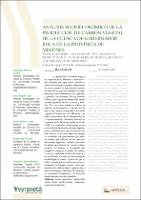Caracterización de un bosque secundario y resultados iniciales de la aplicación de dos tratamientos silviculturales, en la reserva de Guaraní
Characterization of a secondary forest and initial results of the application of two silvicultural treatments in Guarani Reservation.
Date
2019-12-17Author
López Cristóbal, Lidia Mirta
Vera, Norma Esther
Dohman, Romario Andrés
Metadata
Show full item recordAbstract
El objetivo del trabajo es presentar los avances obtenidos en la caracterización inicial del bosque secundario de la Reserva de Uso Múltiple Guaraní y los primeros efectos de la aplicación de tratamientos silviculturales, dirigidos a aumentar su valor como sistema de producción. Trabajando en subparcelas de 0,5 ha, se evaluaron inicialmente el estrato arbóreo y la regeneración natural. En una de las subparcelas se plantaron en fajas cuatro especies nativas y en la otra se redujo el 20 % del área basal inicial. Los resultados del relevamiento inicial señalan que el bosque presenta buena evolución en estructura, con 620 ind/ha y 30,6 m2/ha; la riqueza es de 29 especies, con predominio de la clase comercial C y especies sin valor comercial. La supervivencia de plantas en el enriquecimiento fue 64% y los crecimientos en diámetro y altura fueron bajos. En la apertura del dosel el número de renovables y la riqueza aumentó luego del tratamiento. Los tratamientos aplicados muestran efectos positivos en la recuperación del bosque; en ambos casos se deberá ajustar el grado de apertura para favorecer el crecimiento de las plantas y lograr un mayor establecimiento de la regeneración de especies de valor comercial. The objective of the work is to present the results obtained in the initial characterization of the secondary forest in Reserva de Usos Múltiples Guaraní and the first effects of the application of silvicultural treatments, aimed at increasing its value as a production system. Working in subplots of 0.5 ha, the tree stratum and natural regeneration were initially evaluated. In one of the subplots four native species were planted in strips and in the other 20% of the initial basal area was reduced. The results of the initial survey indicate that the forest has a good evolution in structure, with 620 ind / ha and 30.6 m2 / ha; 29 species, with predominance of the commercial class C and species without commercial value. Plant survival in enrichment was 64% and the growth in diameter and height were low. At the opening of the canopy the number of renovations and enrichment increased after treatment. The treatments applied show positive effects on forest recovery; In both cases, the degree of opening should be adjusted to favor the growth of the plants and achieve a greater establishment of the regeneration of commercially valuable species.
Collections
- Revista Yvyraretá [360]
The following license files are associated with this item:



